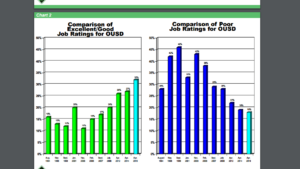By most accounts Oakland Unified is doing pretty well. Our schools are as fully staffed as they have been in recent memory, public support is at historic highs, academically we are making progress and progress with some of most historically underserved students, and financially we are as strong as ever, with an improving bond rating.
So despite the rancor in Oakland, things are going relatively well.
Nobody should be satisfied either with where we are or even the pace of progress, but most should agree that we are moving in the right direction.
The District has developed some of its own notable successes, like Coliseum College Prep, which boasted a 91% grad rate, in the Flatlands. It has also smartly expanded bilingual support, restorative justice practices and specialized support programs like the African American Male Achievement Initiative.
You can see from the graph below—the public is liking what they are seeing based on the most recent polls (you can click the graphic for a clearer image)
But before we call it a day and proclaim mission accomplished there are some thorny issues that need to be tackled
Some Big Challenges Ahead
Overall Achievement and Equity– Even with the increases in graduation rates, they are still too low for many subgroups. Native American students have less than a 50% graduation rate and English language learners, Pacific Islanders, Latinos, African American males and special education students are under 60%. And while this is the best it has ever been in Oakland, it’s not good enough. And as I keep harping on, Oakland has some of the most unequal access to quality schools in the country.
Read the report (above) page 32, low income students in Oakland are 18 times more likely to be in the lowest scoring schools on reading—the largest disparity in the country. And while racial achievement gaps are slowly closing, they are still too wide for anyone to be comfortable with, I hope.
Facilities– While Oakland Unified had a slight uptick in enrollment this year from 36,981 to 37,089 students, it is a district with significantly fewer students than 15 years ago (even when charter students are added to district students). And many charters are in private buildings.
Here’s the chart from the latest 2012 OUSD Facilities Master plan
OUSD has some buildings bursting at the seams, and others less than half full, it also has undeveloped lots. At the same time, the growing charter sector has struggled to find adequate school spaces, even as the voters gave them the right to “reasonably equivalent” public facilities in Proposition 39. This is part of a larger issue of coordination between charters and the district, which is being worked through in the equity pledge.
So I know some folks don’t like it or personally agree but by law charters are public schools and by law they have a right to basically equal public facilities. Oakland has not provided those buildings to charters (and I know it’s tricky) but right now OUSD is likely on the losing side of multi million dollar lawsuit from the State Charter Association.
We need to find a better way to allocate sites, and also settle this suit. There are a lot more losers than winners if OUSD’s students are on the hook for legal fees and damages. Some solutions in a future blog, but it’s completely doable.
Staffing stability and local trends
Without great, committed, responsive, stable staff nothing else will matter. No workplans, no curricular changes, no technology, no restorative justice, or career preparation—it all depends on staff. And Oakland’s turnover is too high, particularly in special education and harder to staff subjects.
This is a tough one, Oakland will never be able to pay what wealthier districts can, based on how California funds schools. We also will continue to have a high need student population, who really need, great and responsive teachers.
With rapidly rising rents and property prices, many Oakland teachers won’t be able to live here. These and other factors conspire to continue a churn of educators and ongoing vacancies, and instability for children who need consistent, caring adults.
OUSD will need to work with the City, other local governments, and developers to get creative on teacher housing and affordability. And we also need to do a better job with the incredible human capital in Oakland. I am shocked to see the challenges we have finding bilingual staff, when we have a ton of smart, hard working, passionate former Oakland students, or others who would feel at home in Oakland, we might more deliberately develop.
But we will need to get creative here, and really do more with less traditional resources. Adequate funding is a continuing issue in Oakland that requires a statewide funding fix. And while we should work for that, we can’t wait for it.
Thank You
Oakland is doing relatively well. This is a credit to the Board, Supe, staff, stakeholders and families. This is incredibly, hard, hot, and contentious work, and the stakes could not be higher. So let’s keep the progress moving, the debate robust and civil, and tackle some of our ongoing issues together.
I obviously have not agreed with everything the Board has done, but I have generally admired their commitment, and deliberations, in a very difficult and thankless job.
Looking forward to another year of progress, hopefully with more light and less heat.
Please follow me on twitter , facebook, or join the blog to the upper right on this page




OUSD is almost fully staffed with Superintendent Wilson on day one saying short 4 classroom teachers on opening day. Other part of the story is that fully staff now means staffed with less that fully qualified teachers with the District asking for 48 permits for teachers to teach that do not have full credentials. And, add on to that bad news is that fact that 12 new teachers have had to had the standard test for California teachers, the CBEST, waived in order to fill in with less than qualified teachers.
I’m not sure if it is still a requirement to inform teachers that their child is being taught by a less than qualified teacher.
I guess with all the charter schools in Oakland there are not enough fully qualified teachers to cover public schools.
You know about Oakland charter schools. They are the schools that the Oakland charter friendly School Board can’t seem to properly oversee and the Southern California ACLU found 18 Oakland charter schools webpage to have enrollment policies that are discriminatory. even requiring illegally information that undocumented students parents would not have.
So are you saying that historically the district used to have less emergency credentials etc. I dont think that is factually accurate. And I don’t think its charter competition for staff so much as the broader crisis in the teacher market and the funding. Even without any charters Oakland still couldnt compete with Piedmont on salaries or many other urban districts– but if you have numbers to back up the statements I am happy to stand corrected